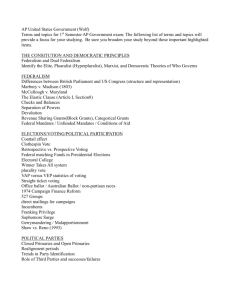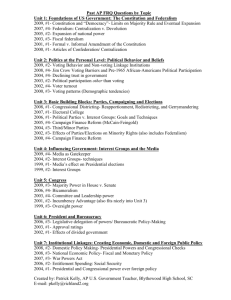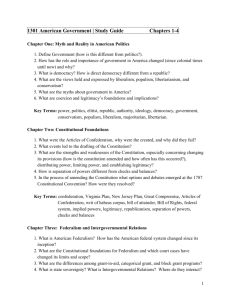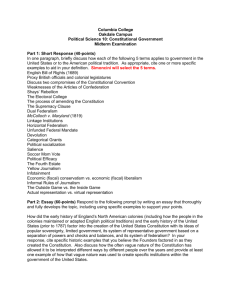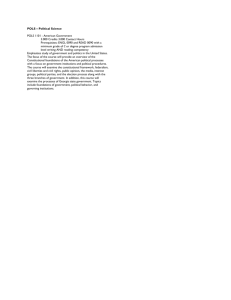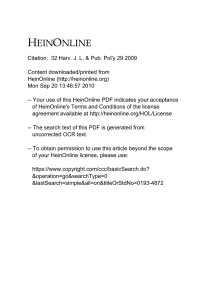POL 211 - Northeast Alabama Community College
advertisement
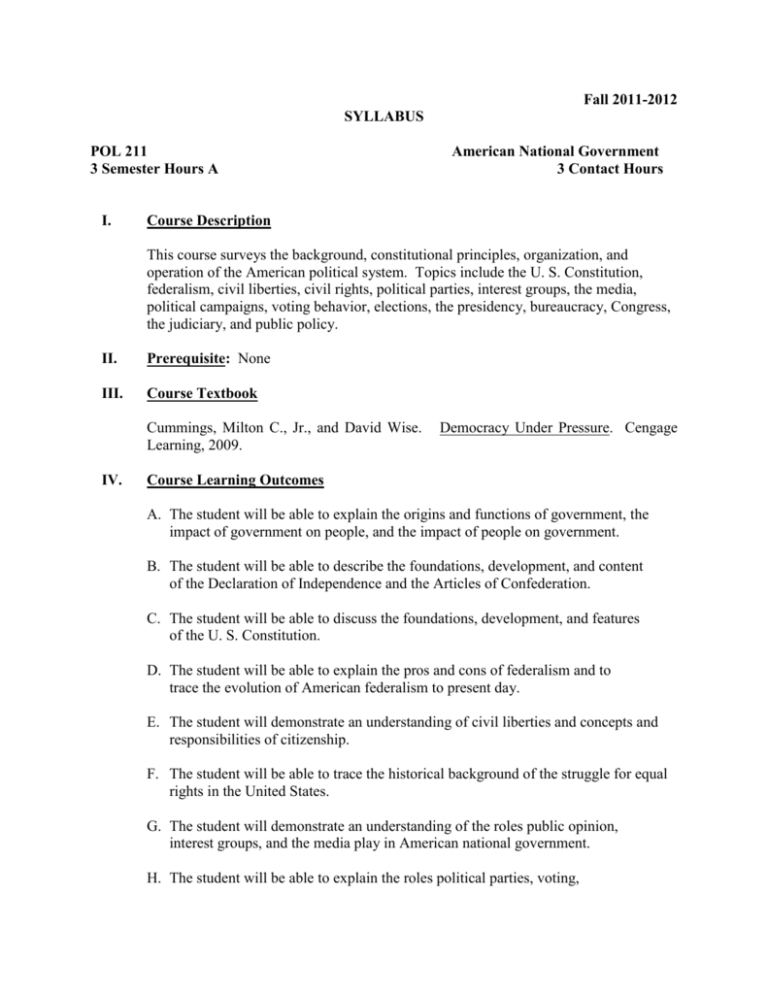
Fall 2011-2012 SYLLABUS POL 211 3 Semester Hours A I. American National Government 3 Contact Hours Course Description This course surveys the background, constitutional principles, organization, and operation of the American political system. Topics include the U. S. Constitution, federalism, civil liberties, civil rights, political parties, interest groups, the media, political campaigns, voting behavior, elections, the presidency, bureaucracy, Congress, the judiciary, and public policy. II. Prerequisite: None III. Course Textbook Cummings, Milton C., Jr., and David Wise. Learning, 2009. IV. Democracy Under Pressure. Cengage Course Learning Outcomes A. The student will be able to explain the origins and functions of government, the impact of government on people, and the impact of people on government. B. The student will be able to describe the foundations, development, and content of the Declaration of Independence and the Articles of Confederation. C. The student will be able to discuss the foundations, development, and features of the U. S. Constitution. D. The student will be able to explain the pros and cons of federalism and to trace the evolution of American federalism to present day. E. The student will demonstrate an understanding of civil liberties and concepts and responsibilities of citizenship. F. The student will be able to trace the historical background of the struggle for equal rights in the United States. G. The student will demonstrate an understanding of the roles public opinion, interest groups, and the media play in American national government. H. The student will be able to explain the roles political parties, voting, campaigns, and elections play in American government. I. The student will be able to explain the structure, functions, and operations of the the three branches of the United States government. J. The student will demonstrate an understanding of the development and implementation of both foreign and domestic policies. K. The student will be able to demonstrate a knowledge of relevant current events. V. Activities Promoting General Learning Outcomes A. Communication Reading--Students will read select current events articles from The New Times on-line. B. Cognition Critical thinking—Students will be required to submit written analyses of political cartoons. VI. Outline of Course Topics A. Government and people 1. The reciprocal nature of democratic power 2. What is government? 3. The concept of a political system 4. Public policymaking 5. Democratic government and a changing society B. The constitutional framework 1. The political foundations of the American democracy 2. The American Revolution and the Declaration of Independence 3. Toward a more perfect union—the Constitutional Convention (background, the delegates, the setting, the compromises, the document) 4. The battle over ratification and the significance of The Federalist Papers 5. A synopsis of what the Constitution says a. Preamble b. Seven articles c. Twenty-seven amendments C. The federal system 1. The advantages and disadvantages of federalism/a federal system 2. The checkerboard of governments 3. The historical basis of federalism 4. The constitutional basis of federalism 5. The growth of strong national government 6. The impact of federalism on government and politics D. Civil liberties and citizenship 1. The Bill of Rights a. Freedom of speech b. Freedom of the press c. Obscenity d. Privacy e. Freedom of assembly f. Freedom of religion g. Loyalty and security h. Due process of law i. An expanding umbrella of rights j. Balancing liberty and order 2. Citizenship E. The struggle for equal rights 1. Historical background 2. The civil rights movement: freedom now 3. Affirmative action 4. Equal rights: a balance sheet F. Public opinion 1. The formation of public opinion 2. Qualities of public opinion 3. Polling 4. Basic beliefs of Americans G. Interest groups 1. Theories as to “who governs” 2. Interest groups at work 3. Regulating interest groups 4. Interest groups and the policy process H. The media and politics 1. The media—a protected institution 2. Ownership of the media 3. Television and the American political system 4. The press: legal and constitutional issues 5. The press and government 6. The press in a democratic society I. Political parties 1. Definition of the term “political party” 2. Development of American political parties 3. The two-party system 4. Party structure 5. The national convention 6. Political parties and democratic government J. Political campaigns and candidates 1. Organization of campaigns 2. Campaign strategy 3. The issues 4. Campaign techniques 5. Campaign finance K. Voting behavior and elections 1. Who votes? 2. How the voter decides 3. Voting patterns 4. Election 2000: a case study 5. Election 2002: a case study 6. The electoral system 7. Elections and democratic government L. The Congress 1. The varied roles of Congress 2. The legislators 3. The House of Representatives 4. The Senate 5. The party machinery 6. The committee system 7. Congressional reforms and ethics 8. Congress and the budget 9. Passage of a bill M. The President 1. The paradox of the presidency 2. The American presidency—the institution, the person 3. The expanding presidency 4. The impossible burden: the many roles of the chief executive 5. The tools of presidential power 6. The Watergate scandal and the resignation of a president 7. Presidential impeachment, disability, and succession 8. The “splendid misery”: personality and style in the White House N. Justice 1. 2. 3. 4. The system of justice The law The U. S. Supreme Court The American court system 5. Criminal justice in America 6. Organized crime 7. Justice and the American political system O. Government and the economy 1. Managing the economy 2. Tools of economic policy—fiscal, monetary, international trade 3. The American economy in the 21st century P. Promoting the general welfare 1. Government as regulator and promoter 2. Government as protector Q. Foreign policy and national security 1. A brief history of post-World War II American foreign policy 2. How foreign policy is made 3. The defense establishment 4. The military-industrial complex 5. America’s world role in the 21st century VII. Methods of Instruction A. B. C. D. E. F. G. Lectures Class discussion Textbook and supplemental reading assignments Audiovisuals Research assignments Oral presentations Companion websites for students (see textbook web icons) VIII. Evaluation and Assessment A. Procedures for the Assessment of Student Learning 1. Written exams 2. Written/oral quizzes 3. Written book reports 4. Oral presentations (individual and/or group) 5. Class participation 6. Research assignments 7. Homework Grades will be given based upon A = 90 – 100%, B = 80 – 89%, C = 70 – 79%, D = 60 – 69%, and F below 60%. B. Departmental Assessment of General Education Outcomes 1. The general education outcome concerning reading will be assessed through select questions on the comprehensive current events examination given at the end of the course. 2. The general education outcome concerning critical thinking will be assessed through students’ written analyses of at least two political cartoons selected by the instructor. 3. Every five years all POL 211 instructors will conduct an assessment of the course. The appropriate forms will be completed by each instructor and submitted to the division chair. C. Use of Assessment Findings During the Fall in-service of the year following the scheduled review of POL 211, a committee will review all course assessment materials submitted by the instructors and division chair. The committee will send a report of any recommended curriculum changes to the division chair, who will then submit them to the Student Learning Outcomes (SLO) Committee. Upon approval by the SLO Committee, a copy will be filed with the Office of Institutional Planning and Assessment. IX. Attendance Students are expected to attend all classes for which they are registered. Students who are unable to attend class regularly, regardless of the reason or circumstance, should withdraw from that class before poor attendance interferes with the student’s ability to achieve the objectives required in the course. Withdrawal from class can affect eligibility for federal financial aid. X. Statement on Discrimination/Harassment NACC and the Alabama State Board of Education are committed to providing both employment and educational environments free of harassment or discrimination related to an individual’s race, color, gender, religion, national origin, age, or disability. Such harassment is a violation of State Board of Education policy. Any policy or behavior that constitutes harassment or discrimination will not be tolerated. XI. Statement of Adherence to ADA Guidelines The Rehabilitation Act of 1973 (Section 504) and the Americans with Disabilities Act of 1990 state that qualified students with disabilities who meet the essential functions and academic requirements are entitled to reasonable accommodations. It is the student’s responsibility to provide appropriate disability documentation to the College.
